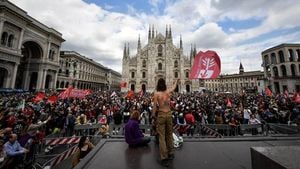In a provocative display at the Glastonbury Festival this past weekend, the renowned street artist Banksy launched an inflatable migrant boat, complete with dummy figures representing migrants, into a sea of festival-goers. The act, which coincided with the performance of the punk band Idles, drew both applause and condemnation, but ultimately served as a stark commentary on the ongoing migrant crisis affecting the United Kingdom and beyond.
The inflatable vessel, appearing during a rendition of Idles’ song "Danny Nedelko," sparked a wave of controversy, particularly after the UK Home Secretary James Cleverly characterized it as "vile," labeling it a "celebration of loss of life in the Channel." Cleverly's comments underscore the political sensitivities surrounding immigration in the UK, particularly amidst soaring numbers of migrant crossings via small boats across the English Channel.
As the boat was carried through the crowd, revelers initially thought it was part of the band's performance, aligning with Idles' themes of immigration and social justice. However, the band's representatives clarified that they were unaware of the stunt until after their set, indicating Banksy’s autonomous approach to art and activism. The performance came at a time when migration issues have been poignantly at the center of public discourse, especially with government policies aiming to curb illegal crossings and the tragic events that ensue from such perilous journeys.
Following the launch, the Home Secretary appeared on Sky News, criticizing the public's reaction to the art. He argued it trivialized serious matters, stating, “There are a bunch of people there joking and celebrating about criminal actions which costs lives. People die. This is not funny. It is vile.” His remarks reflect a broader tension between the artist's free expression and the political ramifications of such expressions.
Historically, Banksy has actively used his art to address pressing social issues, particularly migration. His previous ventures include funding a rescue boat named the Louise Michel, which operates to save migrants attempting to cross the Mediterranean. This duality of art and activism has made Banksy a polarizing figure, capable of sparking intense debate through his work. For instance, his 2019 piece depicting Steve Jobs, the founder of Apple, as a migrant advocated for empathy in understanding the contributions of immigrants to society.
This year's Glastonbury Festival had its own dedicated area focused on migration, aptly named Terminal 1, where festival-goers encountered art and music highlighting immigrant stories. The area featured performances and installations from diverse artists, further solidifying its commitment to addressing this humanitarian crisis.
The fact that Banksy’s latest stunt occurred within a festival heralded for celebrating diversity and social activism speaks volumes about the current climate regarding immigration and refugee issues in the UK. With figures indicating a sharp uptick in small boat crossings—over 12,000 reported in the initial half of 2024—the conversation around how these individuals are treated is more urgent than ever.
In the wake of the Glastonbury incident, public opinions varied, with some hailing Banksy’s art as a necessary spotlight on the migrant crisis, while others condemned it as in poor taste, given the reality of loss that many families face. One festival-goer expressed discomfort, noting, "Punting an inflatable prop of a dinghy full of immigrant children to drunk revellers is absolutely inappropriate in that setting." The intersection of art, politics, and ethics has never felt more pertinent than in today’s socio-political landscape.
Moreover, with the UK general elections looming, politicians are likely to face increased scrutiny regarding their immigration policies. Cleverly, acknowledging the constraints imposed by the opposition, stated that the left’s perceived hypocrisy complicates solutions. He cited that attempts to ameliorate the situation have been hindered by the Labour party's policies. This political finger-pointing highlights the ongoing struggle to find consensus on how best to address the influx of migrants seeking safety and opportunity in Britain.
While Banksy's provocative art interrogates these pressing issues, it remains a reminder of the need for balanced, compassionate discussions around migration—one where artwork can inspire empathy rather than division. In a climate characterized by harsh rhetoric and policies, such expressions remind society of the human stories behind headlines. As the debate continues both in the art world and in political arenas, one thing remains clear: the dire circumstances migrants face will only continue to thrive in public consciousness, inviting both critique and compassion as the UK navigates its complex relationship with immigration.
The narrative spun by Banksy's inflatable boat at Glastonbury thus becomes more than just an artistic stunt; it encapsulates the essence of a larger dialogue about humanity, borders, and the right to sanctuary, inviting everyone to pause and reflect on the lives lost at sea, often overshadowed by politics and policy. As the festival wraps up, the echoes of Banksy’s statements remain—challenging, unsettling, yet undeniably crucial to the ongoing discourse on migration.



